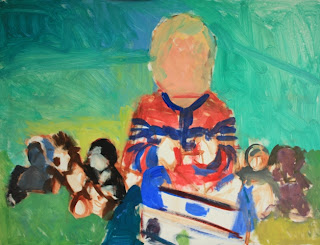This drawing is one of Lyn, a lady who models for lots of art classes and groups around the Cambridge area.
It was done on tinted Murano mount board using a range of different pastels. I use both Winsor and Newton and Senellier soft pastels , as well as charcoal ( willow sticks and charcoal pencils) and conte.
My initial tentative steps at placing the figure on the board are shown above. As can be seen, I didn't get it right first time, and changed the format to landscape. Frustrating, but there is no point in struggling on if the initial planning is wrong. This is done in charcoal. Here I am looking at rhythms through the figure, at basic proportions and angles. It is a very linear method and is only one way of approaching it. I will be considering alternative methods in future blogs.
As I am fairly happy with the basics, I now start blocking in the main masses paying a little attention to tone and colour. I say "little" because these are only the first tentative steps and I know that these will eventually be overlaid and modified. The darker areas are burnt sienna, the lighter tones naples yellow and yellow ochre.
I now have to consider the background and begin blocking it in. I also make a start on the head. I am able to use soft pastels because very little fine detail is required on these larger areas. Sections like the head, hands and feet, I am careful not to overload and will dust them down before continuing on them. I use a combination of fingers, torchons and clothes to blend. How much blending one does is obviously a matter of personal preference or can be dictated by the subject matter. A wizened old man would suggest a bolder approach as opposed to the soft flesh of a baby.
The process continues. I pay more attention to light , shadows and reflected lights. I try to suggest the roundness of the forms and am also looking more closely at subtle colour variations within the flesh. I find myself adding cool blues and greens , overlaying them with softer pinks , sometimes blending them together , at other times leaving the colour underneath breaking through. This is a little like scumbling technique as used in oils. I am frequently asked what should my palette be? Everyone likes a formula it would seem. With pastels, I am a little at a loss for an answer. I have hundreds of pastels. The actual process is for me, to a large extent, almost intuitive. I look closely and what I observe suggests a colour. Sometimes it seems a bizarre choice , but when blended works. Often, when I am doing a pastel demo to an art group, I start off using somewhat weird colours. It has a wonderful shock effect on the audience and certainly captures their attention. They clearly think I am mad! But the trick is to be able to pull the rabbit out of the hat and show
that by adding and overlaying, even this initial "disaster" can be turned into something pleasing.
When it comes to the head, I use a combination of conte crayons and pastel pencils then overlay in places with softer pastel.
The same approach is used when it comes to hands and feet.
Other areas are left softer and more diffused.
The finished drawing.
It was an attempt at a classical pose, both gentle and graceful. There was no desire to shock and reveal all. In many respects it is harder to capture the subtlety than present the viewer with a work where absolutely nothing is left to the imagination.
Perhaps that will be the subject of a future blog.







































